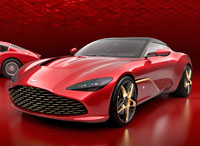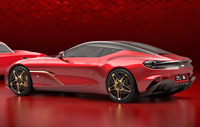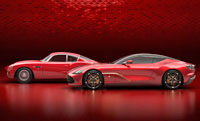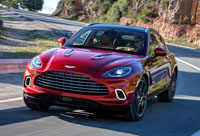
Everyone has been expecting an ultra-luxe SUV from Aston Martin for years, and thankfully the production-trim 2021 DBX that was introduced at the LA and Guangzhou auto shows last week (after a private showing during the 2019 US F1 GP earlier in November) is a lot more attractive than the luxury brand’s Lagonda Concept that caused much controversy at the Geneva auto show way back in 2009.
To be totally fair, Dr. Ulrich Bez and his design team were quite ahead of their time with that early luxury crossover SUV concept, and looking back its squarish front design and sharply angled LED headlights would have stood the test of time fairly well, but the mid-‘30s-era Lagonda de Ville Saloon-like upright opera-style rear window and similarly retrospective curved notchback trunk would never have won over many would-be buyers, whereas today’s Chief Operating Officer, Andy Palmer, and his updated design team (with Herr Bez still acting as non-executive chairman) made certain that this new DBX would be attractive from nose to tail.
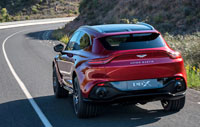
The DBX’ rear three-quarter vantage point might possibly its best angle, in fact, while the frontal design may actually offer up a more classic Aston Martin appearance than any other model currently available, or at least it’s more traditional than the futuristic Vantage and wildly exotic Valkyrie supercar. This said, Aston turned to the new Vantage for the DBX’ body-width LED taillight design, which outlines the new SUV’s shapely tailgate, while its front end looks more like the beautiful new DB11. All in all, most premium crossover SUV buyers should find the new DBX alluring.
DBX’ development took an investment of five years, but despite all the effort there’s no electrified option being offered initially. An “E” version, based on the Rapide E powertrain, is probably on the way, and was the stated power unit used for the original 2015 Aston Martin DBX Concept coupe, as well as the sensational 2019 Lagonda All-Terrain Concept that showed up at the Geneva auto show in March of this year (this SUV heavily inspired by the Lagonda Vision Concept launched the year before), the former a raised, muscled up two-door coupe that shows no resemblance to today’s production DBX, and the latter a super-sleek crossover that may have people asking whether or not Aston is thinking about Lagonda becoming its dedicated electric sub-brand, just like how Volvo is positioning its new Polestar brand, but nevertheless the street-ready DBX gets a more formidable version of the AMG 4.0-litre twin-turbocharged V8 found in the previously noted Vantage and DB11.
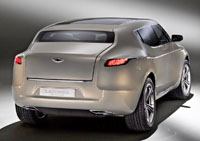
It makes a sizeable 542 horsepower and 516 pound-feet of torque in DBX trim, which is 39 more hp and 11 lb-ft of added torque over both sports cars, but its greater size and mass make it slightly slower off the line at 4.5 seconds from zero to 100km/h, compared to a respective 3.6 and 4.2 seconds for the two-seat Vantage and larger 2+2 DB11, while its terminal velocity is 291 km/h (181 mph) compared 314 km/h (195 mph) and 322 km/h (200 mph) respectively, which is still plenty good for a five-seat sport utility.
Aston Martin incorporates a nine-speed automatic for putting all that power down to the wheels, this gearbox up one cog over both Vantage and DB11 models, while its standard Pirelli P Zeros (and available Pirelli Scorpion Zeros or Scorpion Winters) grip pavement (or gravel, sand, mud and snow) through a standard all-wheel drive system that apportions twist via electronically controlled centre and rear differentials, defaulting from a 47/53 torque-split to nearly 100 percent powering the back wheels. The rear differential combines with brake-based torque vectoring in order to improve high-speed road-holding, while hill descent control helps with steep grades, plus 16-inch rotors binding six-piston front calipers manage stopping power, critically important for this 2,241-kg (4,940-pound) SUV.
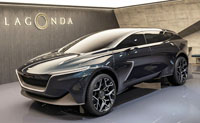
While 2,241 kilos (4,940 pounds) might seem pretty hefty for an Aston, it’s not all that much for a mid-size five-passenger luxury SUV, Aston choosing to use its long history of producing aluminum bodied cars to create the DBX’ completely new bonded aluminum platform architecture. Keeping it horizontal to the road when pushed hard around corners is an adaptive air suspension that’s supported by a 48-volt anti-roll system, all of which is improved upon by six drive settings that include Sport and Sport+ modes, while its standard 198 mm (7.8 inches) of ground clearance can be raised by 46 mm (1.8 inches) when the need to overcome off-road obstacles arises, this scenario aided by Terrain and Terrain+ driving modes. Speaking of going off-road, the new DBX is capable of wading through 500 mm (19.7 inches) of water too.
The suspension can be lowered by about two inches as well, this allowing an easier lift height when loading to its 631-litre (22.3 cubic-foot) cargo compartment, which incidentally can be expanded to 1,529 litres (54 cubic feet) by lowering its 40/20/40-split rear seatbacks, making the new DBX the most practical vehicle ever offered by Aston Martin.
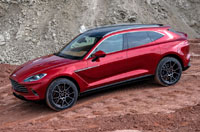
While comfortably seating five and their gear, Aston hasn’t forgotten about pampering those occupants and even their pets. The automaker’s artisans take 200 hours per vehicle to stitch the gorgeous Bridge of Weir leather together, and just a single glance shows its handmade attention to detail. Aston carved out the backsides of the front seats to increase second-row knee room, just like it did with the DB11, while they smartly provided a third seatbelt in the middle of the bench seat.
Of interest, the launch of the DBX is accompanied by loads of accessories, some less significant in size, such as a leather key pouch, a leather umbrella strap, and a leather centre console organizer, with others quite a bit larger such as the “Halo” upgrades that include an event seating package (that adds a rear-facing third row for tailgate parties), a leather upholstered hamper, and a leather-covered field sports cabinet.
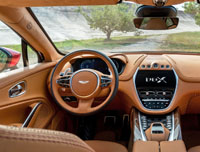
Additional DBX accessories include special form-fitting saddle bags that attach to the folding second-row centre armrest, rear outboard “comfort” leather headrest pads, a branded leather child safety seat, a warming ski boot bag, adjustable roof rail cross-members, lockable roof-mounted storage, top-mounted and rear-mounted bike racks, a leather and cloth flip-out rear bumper protector (designed to stop dogs nails from scratching the rear bumper when jumping aboard), a dog/cargo partition, a dog wash system (complete with a hose), and a roll-up leather and grey cloth doggy bed.
A shortlist of standard features includes 22-inch alloys, frameless windows, individual armrests for front occupants, ambient lighting with 64 different colours, and a big panoramic glass sunroof, while if you’re worried about Aston’s beautiful handiwork getting faded from too much overhead light, a powered sunshade can block out mother nature, this available in Alcantara to match an equally suede-like headliner.
Top-grade leathers and Alcantara microsuede aren’t unusual in an ultra-luxury vehicle, let alone plenty of SUVs from lesser brands, but Aston Martin provides myriad alternative interior options too, like the DBX’ 20-percent synthetic and 80-percent Australian lambs wool upholstery, which the British brand says is a “luxurious felt-like fabric.”
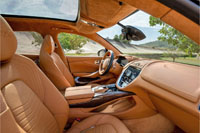
Other alternatives include leather upholstery brogue detailing, quilting, perforations and colour splits, plus many veneer options. If you’d like something even more unique, Aston’s “Q” customizing shop will design an SUV that would make 007 proud (the DBX will soon make an appearance as James’ family car in the 25th Bond film, “No Time To Die”).
On a more pragmatic note, the DBX comes standard with a 12.3-inch high-definition digital gauge cluster, while the centre display is an equally bright and clear 10.25-inch screen. Aston chose to attach the new infotainment system directly to the centre stack instead of standing it upright atop the dash, like so many competitors do these days. As for features, the interface only offers Apple CarPlay, so Android smartphone users will be force to rely on the standard layout, but a surround parking camera system will enhance the DBX’ safety, as will adaptive cruise control, autonomous emergency braking, lane departure warning, lane keep assist, etcetera.
Of course, the DBX won’t be for everyone due to pricing alone, its $218,400 CAD MSRP making sure of that. This said it’s exactly where it needs to be, i.e. unavailable to the masses yet right in the middle of its ultra-premium rivals. The DBX’ entry price is probably closest to the $240,569 Lamborghini Urus, a similarly sized SUV as well, but the Italian stallion’s standard 641-hp V12 means that standstill to 100 km/h takes a mere 3.6 seconds to complete, while its top speed is an astonishing (for an SUV) 305 km/h (190 mph).
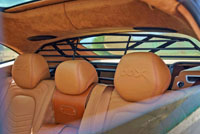
Alternatively, the V8-powered Bentley Bentayga, which is “only” $176,800 in base form, can manage 100 km/h in just 4.5 seconds, which is exactly the same time as the DBX, plus it tops out just one kilometre per hour below the Aston’s 291 km/h (181 mph) top speed, while it seats two additional passengers in its third row and can manage more cargo. The Bentayga can also be had with a 600-horsepower 12-cylinder, this $241,900 utility capable of sprinting from zero to 100 km/h in only 4.1 seconds before reaching a 301-km/h (187-mph) terminal velocity.
Those curious about the new $370,500 Rolls-Royce Cullinan need to realize that its hefty weight gets in the way of its 563 horsepower V12’s performance, thus causing a 100 km/h sprint of (yawn) 5.2 seconds, whereas its top speed is limited to a less breathtaking 250 km/h (155 mph).
At the other end of the pricing spectrum is the somewhat less prestigious Maserati Levante at just $95,500, but its $138,500, 550-hp V8 GTS version is almost perfectly aligned with the DBX in both size and speed, managing standstill to 100 km/h in only 4.2 seconds and an almost identical terminal velocity of 292 km/h (181 mph), plus Maserati also offers its even more potent GTS Trofeo that starts at $187,500 and achieves the same two feats in just 3.9 seconds and 304 km/h (189 mph) respectively.
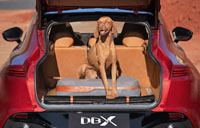
All this said there are a number of less expensive and less prestigious SUVs that can match the DBX in straight-line performance and potentially in the corners, but as painstakingly detailed in this preview already, there’s a great deal more than performance making this new Aston Martin special.
For starters, the first 500 DBX clients will get a special “1913 Package” commemorating 106 years of Aston Martin history. It features special front fender badges, branded sill plates, and an inspection plaque inside that summarizes its limited-build run, while each of these SUVs will be personally inspected and endorsed by the company’s previously noted CEO, Andy Palmer. In addition, Palmer and DBX Chief Creative Officer Marek Reichman will sign an exclusive build book, while all of these special upgrades finalize with an invitation to a cocktail party celebration at the Waldorf Astoria, London, attended by an Aston Martin Lagonda executive team member.
The 2021 DBX will be assembled at Aston Martin’s new Saint Athan, Wales production facility, with deliveries starting in the latter half of 2020. While waiting for yours to arrive, enjoy the many Aston Martin-supplied videos below:
Aston Martin DBX: Behind The Scenes – Daisy Zhou (0:59):
Aston Martin DBX: Launch (9:01):
Aston Martin DBX Chapter 6: In Motion (0:45):
Aston Martin DBX Chapter 5: Adventure (0:55):
Aston Martin DBX Chapter 4: Indulgence (0:51):
Aston Martin DBX Chapter 3: The Engine (0:21):
Aston Martin DBX Chapter 2: The Grille (0:41):
Aston Martin DBX Chapter 1: Testing (0:37):
Aston Martin DBX SUV testing in Sweden (0:39):
2019 DBX – Aston Martin’s first SUV (0:38):

